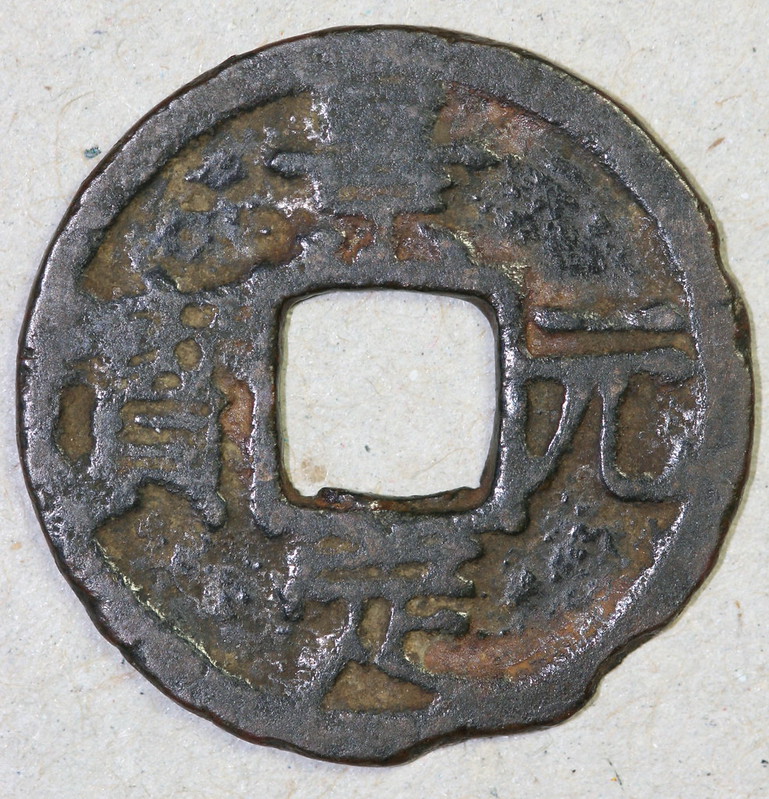Jia Ding Variety Help
I am recuperating from minor surgery (carpal tunnel), so I am taking the opportunity to look a bit more closely at my Chinese cash.
I purchased the Yuan Bao below from a vendor (introduced to me by Zohar, by the way!) who normally does not carry cash.
Much to my surprise, the yuan is at the 3:00 position, rather than the 6:00 position which I believe is normal for this reign. See H17.616 or S905.
Anyway, if someone has another reference, I would be curious to know if I have an unusual variety. The coin is 23.5 mm and 3.2 grams.

I purchased the Yuan Bao below from a vendor (introduced to me by Zohar, by the way!) who normally does not carry cash.
Much to my surprise, the yuan is at the 3:00 position, rather than the 6:00 position which I believe is normal for this reign. See H17.616 or S905.
Anyway, if someone has another reference, I would be curious to know if I have an unusual variety. The coin is 23.5 mm and 3.2 grams.

Honors flysis Income beezis Onches nobis Inob keesis
DPOTD
DPOTD
0
Comments
But with harasha's coin it is written in the traditional manner of top-bottom-right-left. Hartill says nothing about any varieties. But maybe you may have a rare one? Maybe check Zeno. Interesting find. Many would not have noticed.
The second coin also is a larger coin, being about 29.5 mm and weighing 6.4 grams.
A more common coin from Ning Zong's Jia Ding reign is below. This one measures about 29.2 mm and weighs about 6.3 grams.
DPOTD
<< <i>I am recuperating from minor surgery (carpal tunnel), so I am taking the opportunity to look a bit more closely at my Chinese cash.
I purchased the Yuan Bao below from a vendor (introduced to me by Zohar, by the way!) who normally does not carry cash.
Much to my surprise, the yuan is at the 3:00 position, rather than the 6:00 position which I believe is normal for this reign. See H17.616 or S905.
Anyway, if someone has another reference, I would be curious to know if I have an unusual variety. The coin is 23.5 mm and 3.2 grams.
Harasha, this is an interesting post. This coin is a Jingding Yuanbao 景定元寶 (1260-1264AD) from the reign of the Lizong Emperor (r. 1225-1264). All the Jingding Yuanbao have the characters arranged in the 12-6-3-9 pattern. The reverse should bear the year of mintage. Show us the reverse!
As for the "yuanbao," it often refers to a denomination larger than one, but not always. In the case of the Jingding Yuanbao, the smaller variety is one jiao 角 while the larger is 5 fen 分. So says Ding Fubao.
<< <i>Emperor Ning Zong used the yuan at the 3:00 position during his Qing Yuan reign, though if I understand the nomenclature (?) correctly, the yuan is being used as sort of a denomination in the first coin. In the second coin, picutred below, it is used in the reign title.
The second coin also is a larger coin, being about 29.5 mm and weighing 6.4 grams.
A more common coin from Ning Zong's Jia Ding reign is below. This one measures about 29.2 mm and weighs about 6.3 grams.
Harasha, the reverses of the Qingyuan Tongbao Jiading Tongbao bear the year of mintage. Can you show them?
This is one of the things I love about Southern Song coinage. It is unusual for "cash" coins to be dated but Southern Song issues are different. Does anyone know why they are dated?
David Jen writes that placing the year on the reverse "was a way of dealing with illegal minters who lacked the skills to place the reverse moulds properly, thus making forgeries easily recognzable."
Here is the reverse:
DPOTD
I am sure Jen is right but I wonder why we don't see it more commonly on other coins.
At first glance, it gives that appearance, but in my opinion, no. Unless it is a particularly well preserved piece, I suspect an alloy with an iron component or maybe hoarded with iron coins.
DPOTD
This will be very unscientific terminology; I have not studied calligraphy as well as some of my friends.
If you look at the character Jia for H17.616, it has two "blobs" of metal, two characters under the horizontal bar. The horizontal bar is always a strong feature to look for when identifying worn coins, as it separates the figures above and below. You can guess at what the figures are above, eliminate some coin titles, then focus on the characters below. In looking below the bar, there's a strong vertical below a rectangle in the middle, with a worn "blob" either side. It is a Jing character, and not Jia. The Jia character has two characters "blobs when worn" under the bar. Regarding the other characters, you are spot-on.
So I believe this is a Jing Ding yuan bao, read clockwise; yes, Year two (1261). Harthill lists two varieties, a smaller coin (H17.831, S1039, FD 1574, rarity 13) or a larger coin (H17.837, S1043, FD 1579, rarity 14). I looked for my metric ruler, but couldn't find it; sorry. A nice, interesting coin. Southern Song dynasty coins are tougher to get than most people realize, and the fact they are dated so specifically on the back makes them more collectible, I believe.
Harthill does not list an iron variety, but it's not out of the realm of possibility. Test it with a magnet. It was near the end of the Song Dynasty, when they turned to iron due to inflation. The rims are crude enough that it might be a forgery of it's time, or a provincial issue. There looks to be at least two clips off the bottom right, but they appear to be cast. So someone might have been using a clipped real coin to cast this coin.(???)
DPOTD